Along Came a Spiderwort
Now comes mid-June, and the garden is still in something of a blue period, tranquil and calm – at least in the sunny front area.

The flowers of Ohio Spiderwort (Tradescantia ohioensis) have begun contributing to the blue theme, at least in the morning. Spiderwort flowers are beautiful but it’s annoying that they close up in the afternoon.
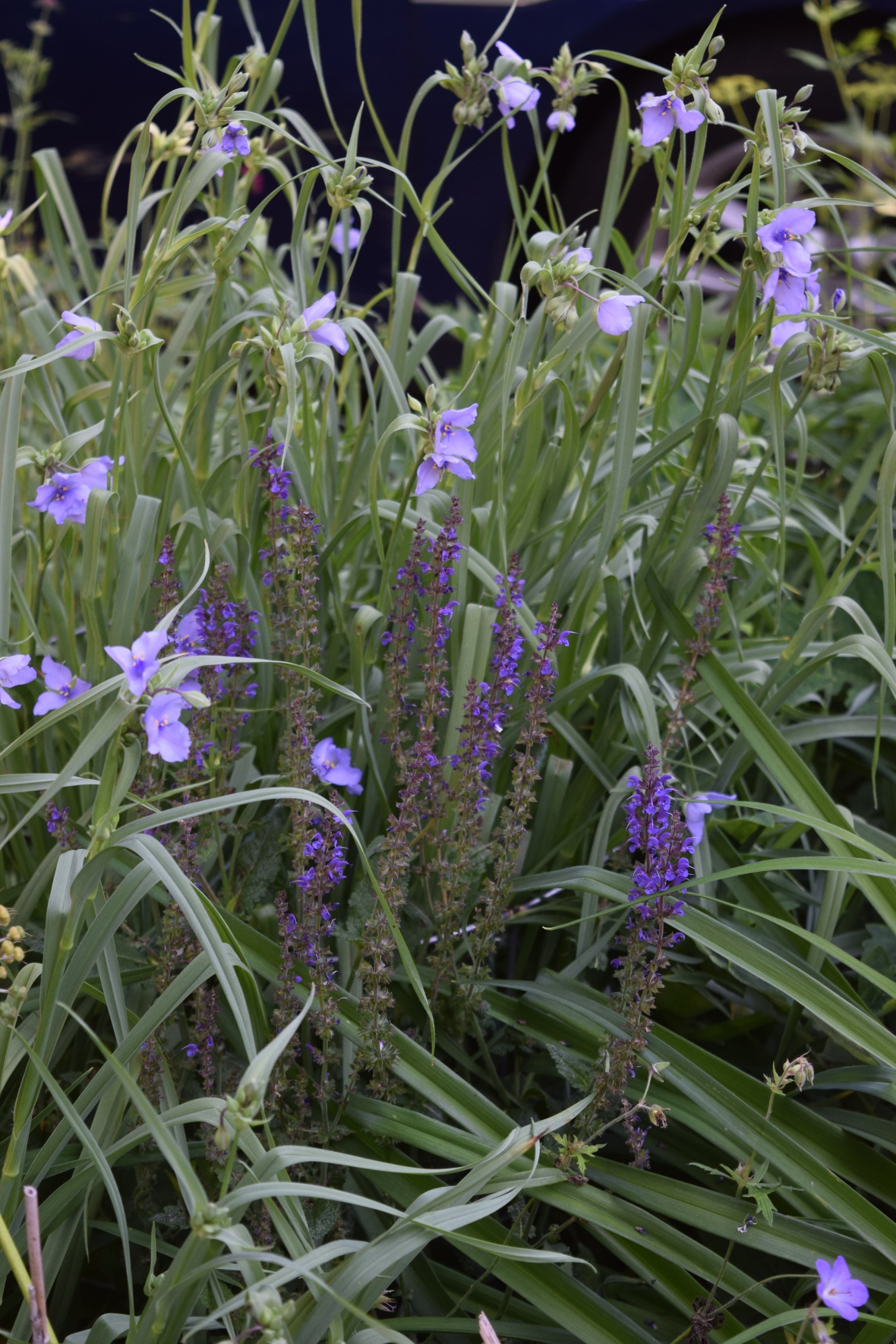
For those of you who are leery of the expansive tendencies of Virginia Spiderwort (T. virginiana), know that Ohio Spiderwort is a polite midwesterner. It makes sizable clumps but does not run, and self-sows only modestly.
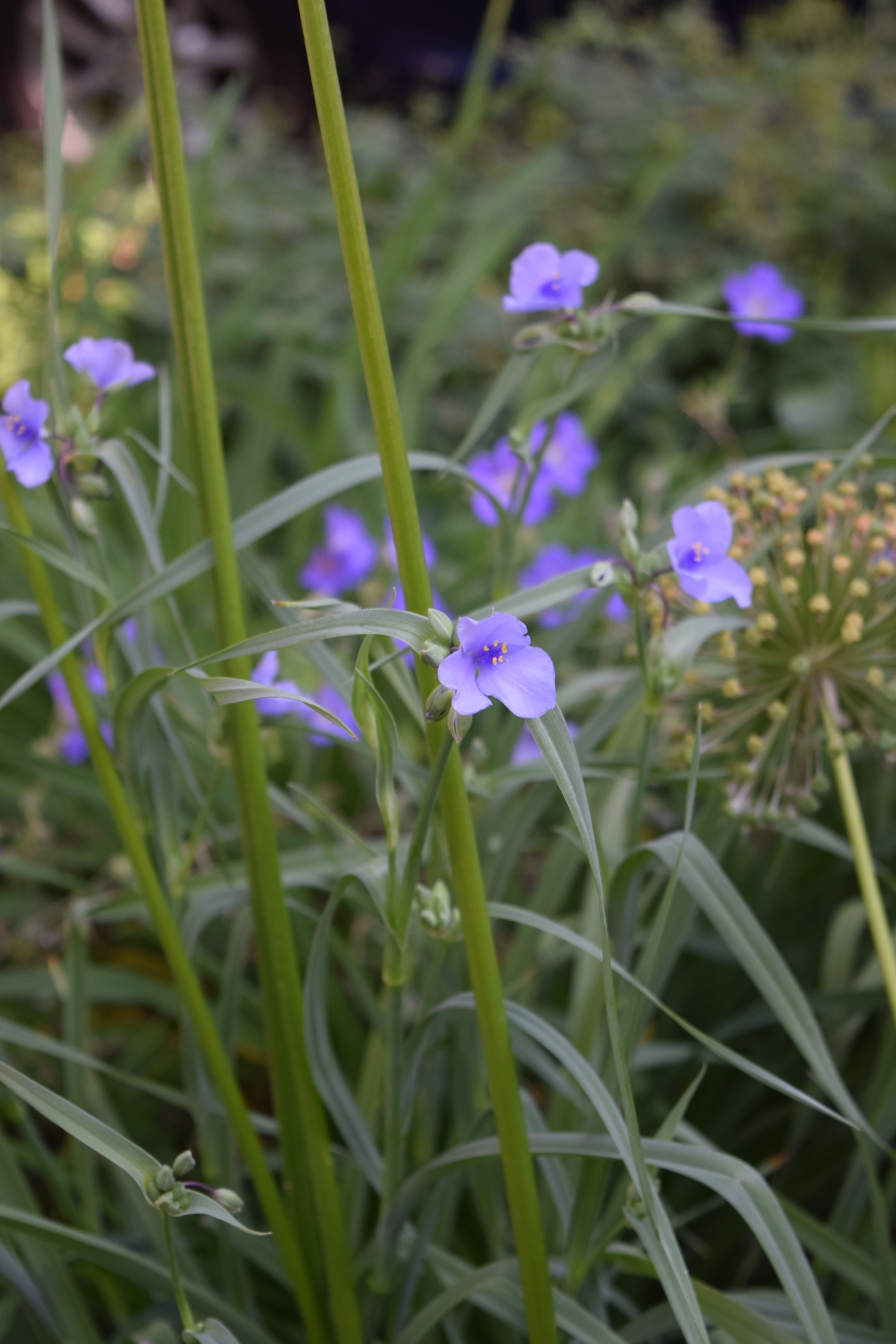
On the other hand, Ohio Spiderwort is rather tall and gangly, and has a tendency to flop. I have used a variety of strategies to entice this plant to maintain an upright habit. Peony hoops can work pretty well, as does providing companion plants that can be leaned upon (as with the Allium stems above).
It is wise to cut Ohio Spiderwort back hard after it is done blooming.

Another new arrival to the Festival of Blue Blooms is Pincushion Flower (Scabiosa columbaria ‘Butterfly Blue’). As a result of poor impulse control, I recently replanted a corner of the Left Bank Bed along the sidewalk with this very compact and long-blooming perennial. Pincushion Flower is also an excellent flower for bees and butterflies. It should fill in in a year or two.

The flowers of Salvia nemerosa ‘Caradonna’ are about done, as you can see from the second photo from the top. ‘Blue Hill’ (Salvia sylvestris), however, still looks very colorful.
Though I have to say that the Salvias generally in the Sidewalk Border have been retreating in the face of the onslaught from the resurgent Wild Geranium (Geranium maculatum). Originally this bed had Wild Geranium bordering the sidewalk. Then, a few years ago I dug out the Geranium and replaced it with Salvia.
The Geranium laughed at my presumption, and started to grow back from seed and the bits of rhizome that inevitably were left behind. The Salvia is at something of a disadvantage because this part of the border is shaded by tall plants in the back of the border, something more easily tolerated by the Wild Geranium.
The Salvia may need to retreat to the Parkway Border, where its comrades are faring better. We’ll see.
I know I posted a picture of the ‘Betty Corning’ Clematis in the Driveway Border recently, but this lets you see how it is starting to fill in. Given that this is ‘Betty’s’ first season in the border, I’m very pleased with her performance. That’s Joe Pye Weed (Eutrochium maculatum) in the background.
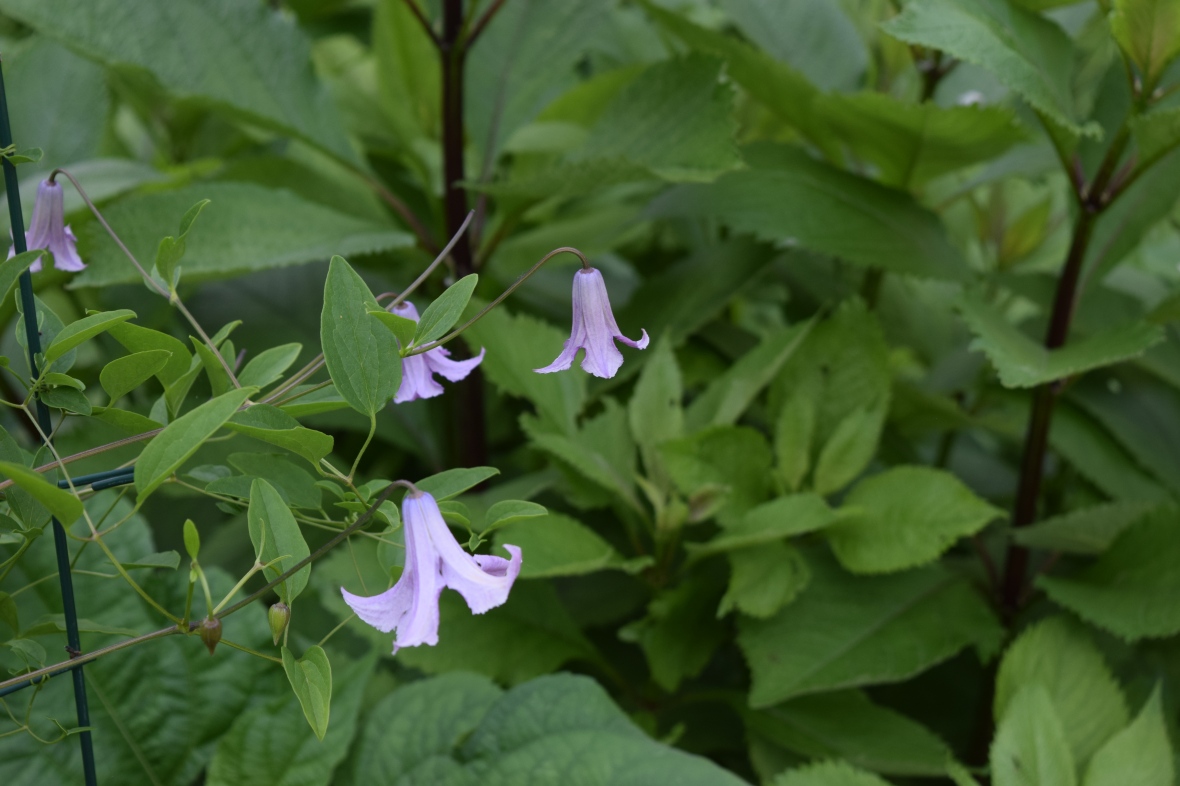
‘Betty Corning’ close up.

There are a few non-blue flowers in the front garden that are worth mentioning at the moment. Smooth Penstemon ‘Husker Red’ (Penstemon digitalis) is blooming in the Sidewalk Border. Like the Salvia, it also seems to be in retreat – there is less of it this year than there was last. Not really sure why.
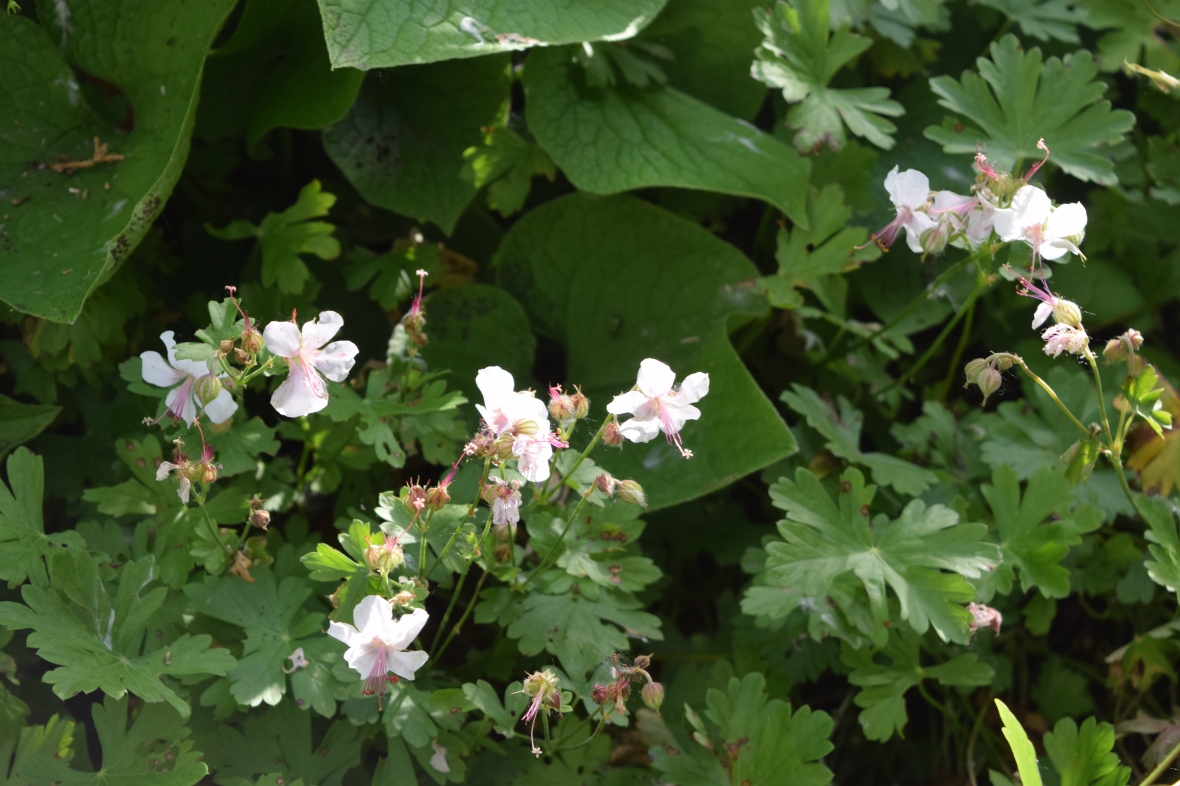
Geranium cantabrigiense ‘Biokovo’ is quite happy in the partly shaded East Side Bed. It has created a dense, low groundcover along part of the edge of the Bed. The white and pink flowers are very comely.
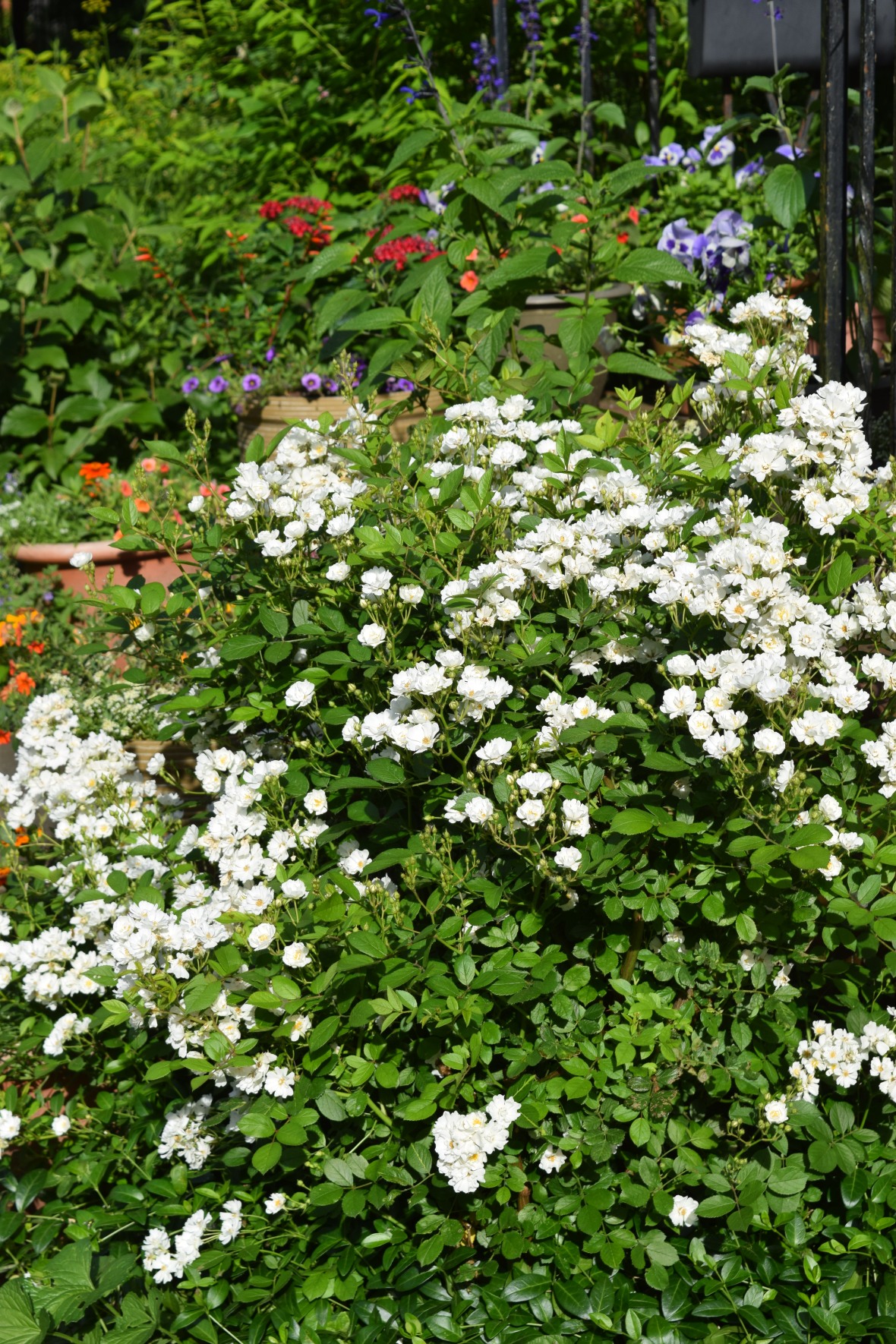
At the risk of being repetitive, here’s another picture of the shrub rose ‘Cassie’, just in case you didn’t believe me in the last post when I talked about how floriferous she is.
In the next post we’ll visit the Back Garden, where white flowers predominate.





I love the blues! i had ‘Husker’s Red’ for about three years. It gradually declined and was gone after year three. Could this be one of those short-lived perennials?
I suppose it could. I’d be wise to consider life expectancy just as much as height, shape, and color.
Great post! I planted a few spiderwort plants, a purple and a white. Now I have purple, lavender, white and fuchsia colored spiderwort….I’m loving it! Of course for now. Love your post and appreciate your discussion of the other plants blooming at this time….although my feverfew blooms in early summer after my spiderworts are all bloomed out.
Sounds like you have almost a Spiderwort rainbow.
Cassie is always welcome in your posts. I hadn’t heard of her before reading about her here. I wish I had more blues but I think that blue flowers need more water- a sweeping comment I know but not many blue flowered plants tolerate drought.
I never thought about blue flowers needing more water. What about Perovskia? Hmm, that may be the only counter example I can think of.
We have Geranium cantabrigiense (thank you for providing me with its real name.) It is very hardy and is a wonderful ground cover. I love the blue Spiderwort flower in the first photo, ”tranquil” blue is right.
Hardy Geraniums are extremely useful plants. I would hate to be without them.
Clematis ‘Betty G’ is very pretty and I do like the look of the Penstemon. Your rose Cassie is gorgeous. I’m all for showing many photos of plants that look as good as this one!
That’s a very good thing for me given my tendency to do just that.
I planted Betty Corning last year too and I am amazed at how fast she has grown. I love blue flowers too, although I am not so keen on Tradescantia with its unattractive foliage and economical little flowers. Cassie is very beautiful. I have never seen it here.
‘ Poor impulse control’. I like that, I suffer from it too, it is a very debilitating condition.
Oh, you are cruel. “Unattractive foliage and economical little flowers.” Now Tradescantia has run upstairs to its room and is sobbing inconsolably. Anyway, why do you think the foliage is unattractive? I think it’s nice.
So weedy and grass like. I do have one in my garden but I sneer at it whenever I see it and threaten to dig it up.
Regarding poor impulse control – tragically, there is no cure. Allowing the afflicted to act out their compulsions is the best course of treatment. That’s my story, anyway.
‘Cassie’ deserves the attention–quite lovely. I adores all these blues. Interestingly pincushion flower is extremely short-lived in my garden as are various geraniums that I’ve tried.
I hope it lasts longer up here. I’ll have to wait and see.
Oh, those blues! But that geranium sounds like a villain from “Dr. Who.” 😉
Never thought of that!
You have some pretty blue flowers. I keep trying with the more dainty Clematis like Betty Corning, but for some reason, I never have much success. My Husker Red Penstemon fails to thrive as well, I don’t know why. I was beginning to think it might be lack of sun. Is yours getting plenty of sun?
I think so, but then there are some very tall plants around them, so maybe not.
That’s a nice looking rose; not a spot on it.
Thanks. Honestly, there never is.
I’ve discovered penstemon aren’t very long lived. After about 5 years or so, they just seem to fade away. Spiderwort reseeds quite a bit for me. Maybe your winters keep yours in check. Everything looks fabulous! Love ‘Cassie’!
Thanks! It’s good to hear that Penstemon are not long lived – so it’s not anything I’m doing wrong.
I have been on the lookout for a Tradescathia (can’t stand its common name, despite your clever play on words) exactly the color you show here. Every one I have found is a deeper blue. I always think of your garden as trending orange, but I guess that comes later. The transition must be spectacular, with blue and orange overlapping(?)
I like to keep some blue going along with the orange and other hot colors.
I did enjoy all your heavenly blues! I’m impressed with your allium support too, must give that a whirl. Gosh, Cassie is a gem!xxx
The flowers aren’t super showy, but overall a great rose plant.
Love the blues, Jason; I grow a lot of the same things, especially the spiderwort and salvias – your photo of that combo is really lovely.
Thank you!
I like the Tradescantia name after the man who found it, John Tradescant. He is buried at St Marys Church, Lambeth Palace Road, London at what is now the Garden Museum. Tradescant was one of the first great gardeners and british plant hunters (1570-1638). Your pictures look great.
I have heard of John Tradescant – didn’t know that he was buried in London, or that he goes back such a very long time.
I think of this as a ‘blue period’ in my garden, too — with Siberian irises, amsonia, and spiderwort providing most of the blues. My spiderwort plants are either a hybrid of T. virginiana and T. aspera called T. x andersoniana or part of the “Andersoniana” group of T. virginiana. The horticultural jury still seems to be out on whether they are true hybrids or not. (Some of mine do seem to come true from seed, suggesting that they are varieties but not hybrids.) They do tend to be a bit tall and floppy, but I find that a peony hoop placed discretely about 6″ above the ground keeps them from flopping. Their flowers are large, come in lovely colors, and are very abundant. Happily, in my Maine climate, it is often cool enough during the day that they do not close up. In cooler summers, they will also keep blooming until fall.
I have forgotten which spiderworts I have. They are certainly tall this year. Taller than seems normal to me. Odd since it has been so dry lately. They have plenty of buds on them. If we get a good rain at some point they should bloom up a storm.
We got a big rainstorm on Friday, just as things were getting pretty dry.